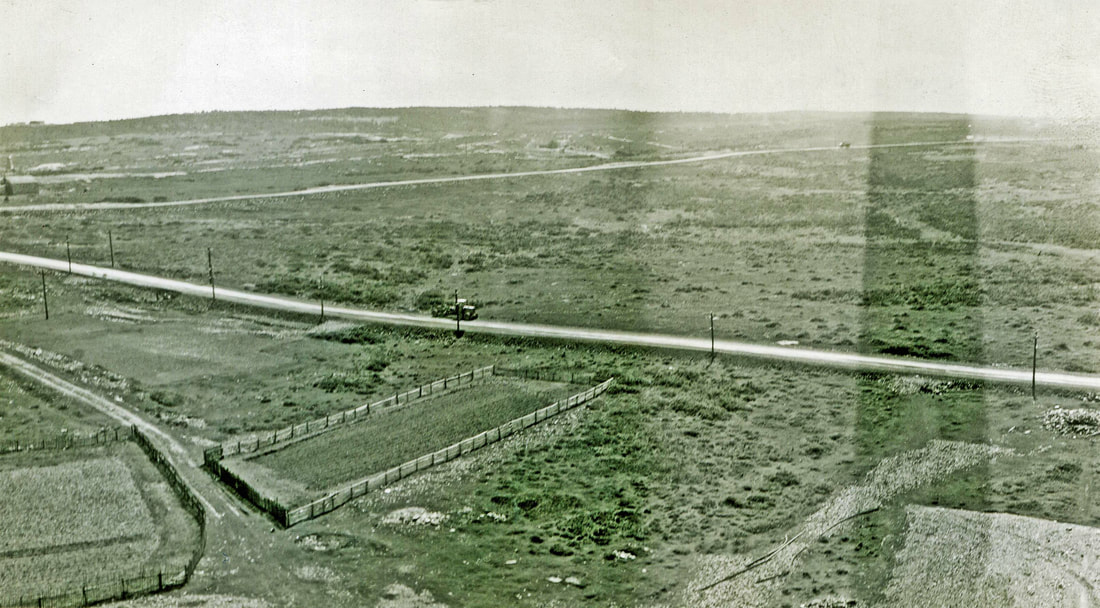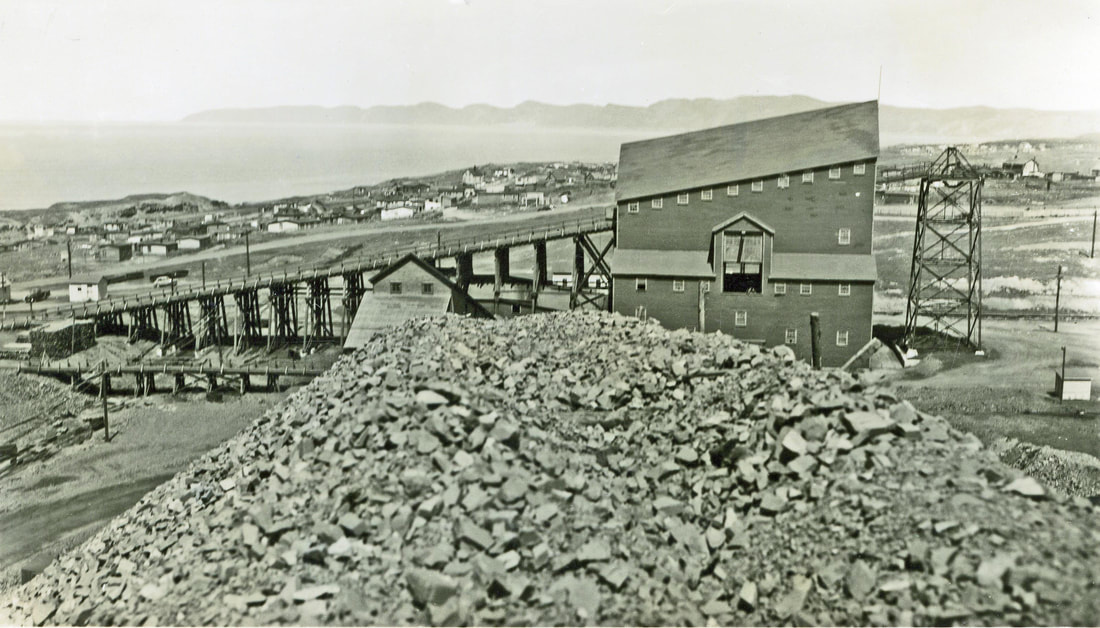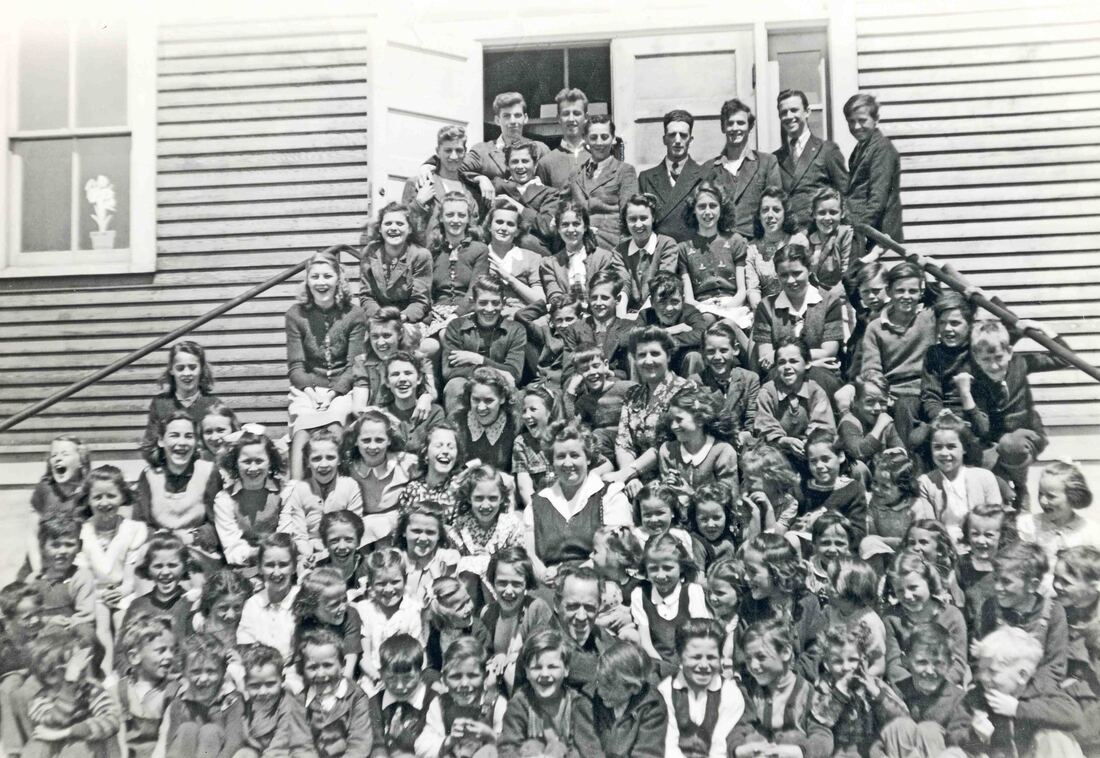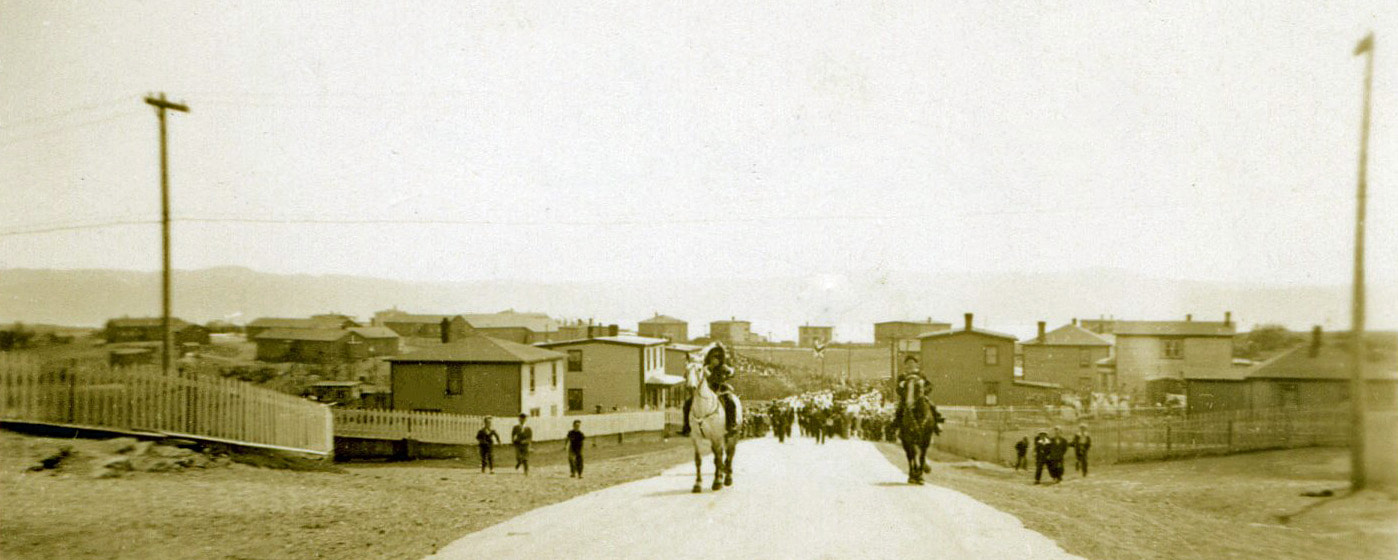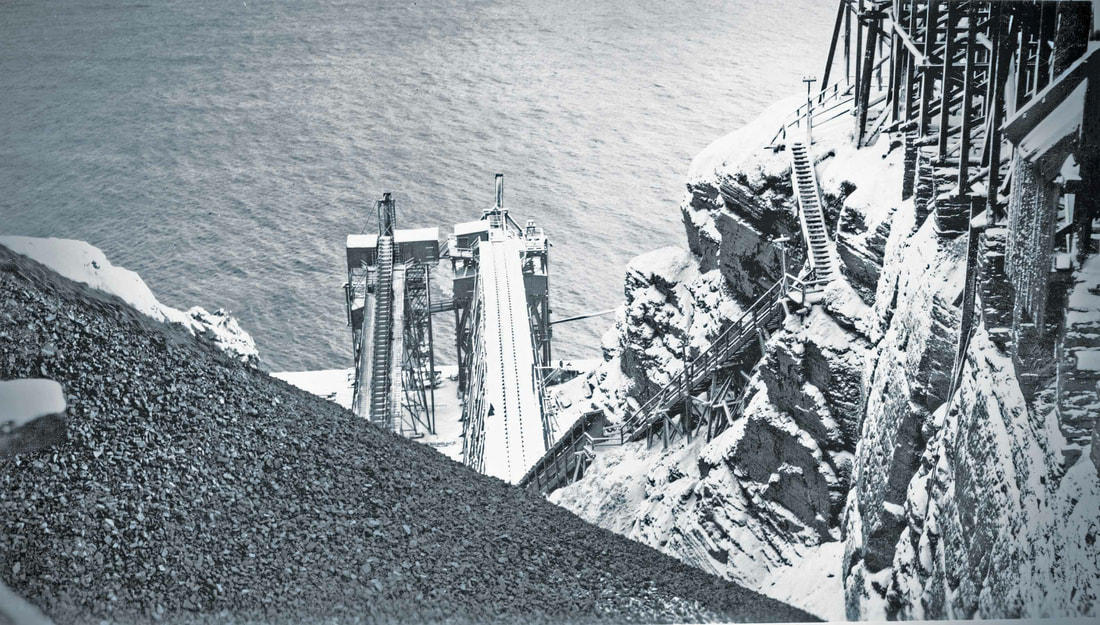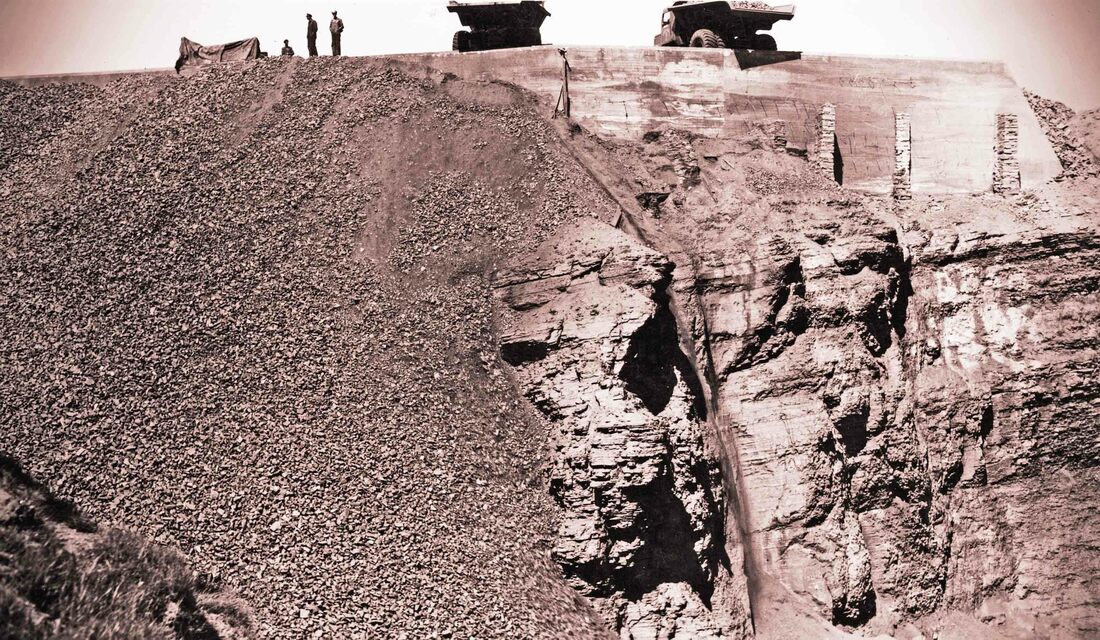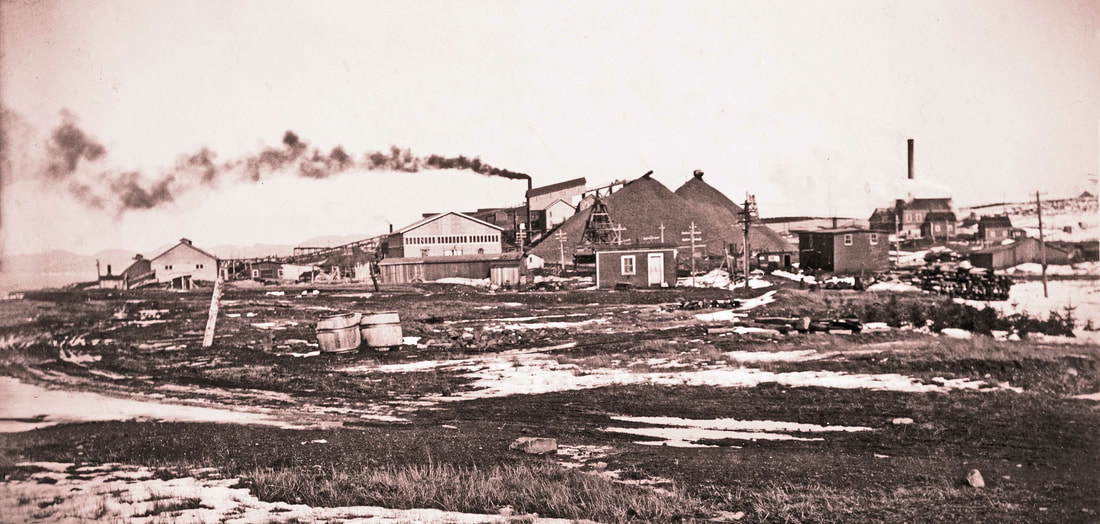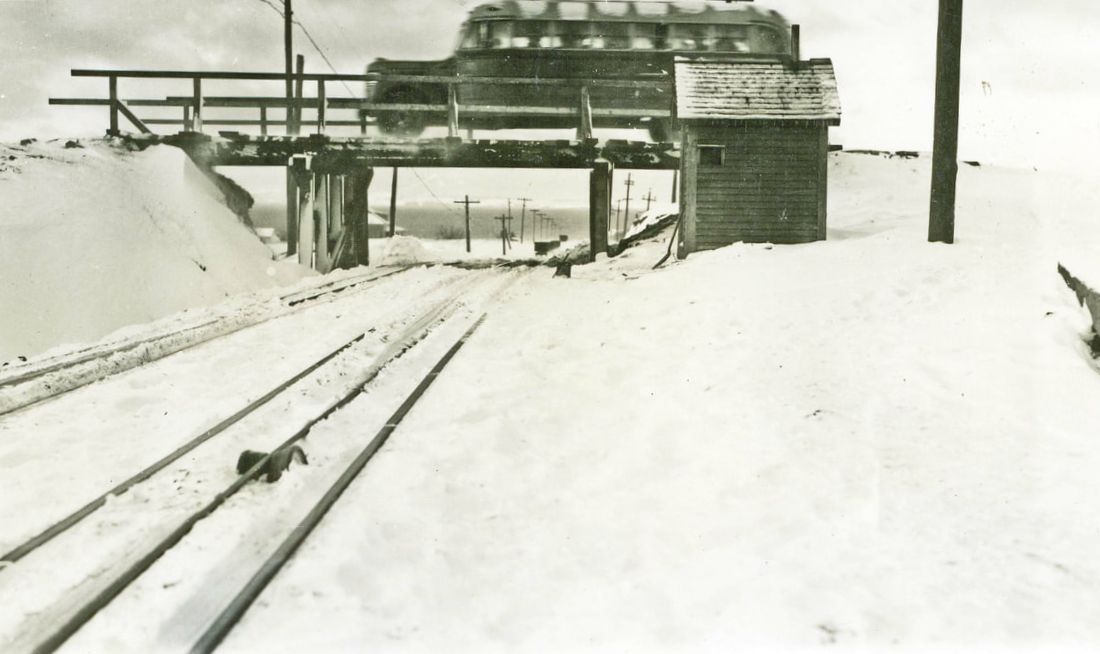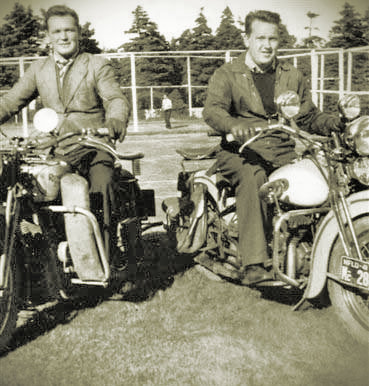PHOTO GALLERY
LINDSAY
by Gail Hussey-Weir
Created April 2019
Many of the photographs on this page were taken by William Lindsay, Sr. (see his bio below), and some were taken by his daughter, Elizabeth, when she was a teenager on Bell Island. Elizabeth donated them to Archives & Special Collections at the Memorial University Library in 1996, where they are now part of the Bell Island Photograph Collection, COLL-202.
Note: Descriptions that are in quotation marks were what was written on the photos.
Note: Descriptions that are in quotation marks were what was written on the photos.
William Lindsay Sr. (1883-1971): Mechanical Engineer; Compressors, Crushers & Hoists Superintendent. He was born October 26, 1883 in Dundee, Scotland. Educated at Dundee and Erith, England. He came to Bell Island in 1910 as a Mechanical Engineer for Fraser and Chalmers of Erith to supervise the installation of No. 3 Hoist machinery. Following this, he accepted the position of Compressors, Crushers and Hoists Superintendent with the Scotia Company, and continued to work with DOSCO at Wabana until retiring in 1951 after 41 years of service. He married Clarice Jackson (c.1889-1946) of Erith, England. Clarice died Oct. 14, 1946 and is buried in St. Boniface Anglican Cemetery, Bell Island. William's second wife was Phoebe Alcock of Corner Brook, who died in 1959 and is buried there. William died in Charlottetown, PEI in 1971 at age 86. He is buried in the People's Cemetery in Charlottetown, where an "iron-ore red" granite headstone marks his grave.
Volunteer Activity: He was the first O.C. of J Company of the C.L.B. when it was formed in 1913; a founding member of the Curling Club and the Lawn Tennis Association, serving as president; a past master of Clift Lodge; secretary of the local branch of the Canadian Institute for the Blind; secretary of the Men's Patriotic Association during WWII.
Sources: The Wabana Star, V. 2, No. 8, Jan. 10, 1962; Vital Records; Jean (Lindsay) Alcock & Elizabeth (Lindsay) Palmer, personal interview, Feb. 18, 1996.
Volunteer Activity: He was the first O.C. of J Company of the C.L.B. when it was formed in 1913; a founding member of the Curling Club and the Lawn Tennis Association, serving as president; a past master of Clift Lodge; secretary of the local branch of the Canadian Institute for the Blind; secretary of the Men's Patriotic Association during WWII.
Sources: The Wabana Star, V. 2, No. 8, Jan. 10, 1962; Vital Records; Jean (Lindsay) Alcock & Elizabeth (Lindsay) Palmer, personal interview, Feb. 18, 1996.
William Lindsay, Sr. is pictured above with the No. 3 Hoist machinery in April 1910 (.014). (See "Maclean's Magazine" under "Publications" in the top menu for another photo of this machinery.)
All-Newfoundland Hockey Champions, 1944 (.001).
"Walt Sellars & Bill Power, Nova Scotia Compressor" (.002).
"No. 3 Mine yard, Paddy Murphy's House (next door to Lindsay's). Ice in the bay beyond" (.003). No. 6 Deckhead in middle distance. No. 3 Deckhead on the right.
View over No. 3 Mine Yard looking NE towards Cape St. Francis (.004). c.1950 (No. 2 Deckhead has been dismantled in middle distance; only the metal supports remain.)
View looking West over Scotia Ore Road from No. 3 Mine Yard (.005). Dominion West Ore Road in background.
View looking Southwest from No. 3 Mine Yard (.006). Road going south to north past the water tower in the top right of photo is the Scotia Ore Road. Community farming allotments in foreground.
"The Beach, Bell Island" (.007). View of wharf at The Beach from the ferry.
"The Wharf, Bell Island" (.008). View of wharf from the hill. Ice in The Tickle.
"The Kipawo ferry, Bell Island to Portugal Cove" (.009).
View of the Wharf, Bell Island, taken from The Beach, pre-1949 (.010).
Looking South from No. 3 Mine yard at four of the five Wall Street Company staff houses with Arena behind, then Scotia Ridge and The Front in the distance (.011). In the 1930s-40s, the first house (left) on Wall Street was occupied by Mary & Paddy Murphy, Chief Engineer with DOSCO. Clarice & William Lindsay lived in the second house. George Case, Timekeeping Department, occupied the third house. Maud & Walter Parsons, mine foreman, lived in the fourth house. May & Arthur Rees, Superintendent of No. 6 Machine Shop, lived in the fifth house (out of the picture on the right).
View over No. 3 Mine yard looking east, c.1950s (.012).
"Bill Ash [on right with waist coat and white shirt], Uncle Ned Kitchen, July 1938, No. 3 Hoist" (.013).
Group of men in oil clothes in front of Mine building. (.015). William Lindsay standing furthest right. Man sitting furthest right may be Dr. Carnochan, who was on Bell Island c.1907 though 1919.
"No. 3 Engine room, April 1910." Probably Company officials at the completion of hoist installation. William Lindsay is the clean-shaven man on the stairs. (.016).
Aerial view of No. 6 Mine Yard (.017). Iceberg in bay.
No. 6 Deckhead (.018). The Valley and The Green in background.
"View of ferry wharves at The Front, Bell Island, Topsail in background" (.019). This is actually two photos that were taped together to form a panorama of The Beach from the hill above it. The Tram Car can be seen on the right. The wharf it serviced is the one in the middle of the picture. The Beach Tramway went into operation on Nov. 29, 1913 and closed in 1948.
View of No. 3 Bridge, West Mines Road, and Scotia No. 1 neighbourhood in background (.020).
Aerial View of area just west of No. 6 Mine Yard (.021). Iceberg in bay.
No. 3 Stockpile (.022). The house immediately behind the right side of the stockpile is the last house on Wall Street. The roof of the Arena is just barely visible behind the right side of the stockpile.
This is a crop of the photo of No. 3 Stockpile (.022) above, showing a closer view of the last house on Wall Street at the left, and Company houses on The Scotia Ridge behind it (to the right in the photo).
"No. 3 Stockpile, Bell Island Mines, Nfld." (.023).
No. 3 "Ore Stockpile, Bell Island" (.024). [Slightly out of focus.]
"Tennis Courts Bell Island" (.025). The Tennis Pavilion and tennis courts were on the west side of Davidson Avenue opposite Mercer Street. It was located on land owned by William Kent and was behind the Kent house. According to newspaper reports, tennis and cricket were being played on Bell Island in 1912. The tennis courts were "going strong" in 1922, and again in 1924, when it was reported in the Daily News that "on its beautiful tree-surrounded grounds off Davidson Avenue, a new pavillion was built that summer." C.B. Archibald, Works Manager of the Wabana Mines, was President of the Tennis Club at that time and Charles Peddle was secretary. In 1932, members of the tennis club took part in a tournament in St. John's for the first time and also went to Carbonear to play. William Lindsay's daughter, Elizabeth, recalled that the tennis courts were no longer being used when she left Bell Island in 1949. The pavilion was still standing in 1962 when the Kent family left Bell Island. After the No. 2 Deckhead was dismantled and the Curling Club set up in its place, a concrete tennis court was constructed next to it.
|
The description of activities at the Tennis Club on the right was written by Stanley Carew in a story about his youth on Bell Island. The time period he refers to would have been the 1920s through 1930s and likely continued through the 1940s after he left Bell Island. Read his full story on the Publications page under "The Book of Newfoundland."
Lester Taylor played tennis there in the 1940s and recalls that you had to be 16 to attend the Saturday evening dances. You walked through Kent's land from Davidson Avenue to access the club. During WWII, sailors from the ore ships would sometimes come to play tennis. Lester remembers some Yugoslav officers playing there. In the picture above, the umpire's chair is on the left and part of the upper court is in the foreground. The left annex was where the change rooms were and the right annex was the kitchen/domestic area. The pavilion had a record player for the members' use. There were two courts, both clay, which had been shipped in from somewhere "around the bay." Sources: Addison Bown, "Newspaper History of Bell Island"; Stanley Carew, "Bell Island was Exciting For a Growing Boy" in The Book of Newfoundland, V. 6, p. 228; Elizabeth (Lindsay) Palmer, personal interview, 1996; Lillian Kent Cruickshank & Lester Taylor on Historic Wabana Facebook Group. |
Students in front of Jackson Memorial School, c.1947-48 (.060). Some of the boys at the back include: Roy Andrews, Norman Normore?, Edgar Case, Joe Luffman and ? Normore. Others in the photo include: Principal Jenkins; teacher Madge Mews; Phyllis Bugden (whose father drowned when the ferries collided in The Tickle in 1940); Minnie Kelloway; Shirley Cantwell; Gertrude Saunders (daughter of Captain Saunders of the Maneco; Nancy King; Elizabeth Lindsay; teacher(?) Sadie Clarke; Rev. Rowsell. [If you can provide any names or the year, please get in touch at "historic.wabana@gmail.com".]
"Jackson Memorial School, Bell Island. Built in memory of Rev. Oliver Jackson after he drowned on the South Coast while on a missionary voyage" (.026). Rev. Jackson served Bell Island-Portugal Cove from 1928-1931. He died Nov. 3, 1937.
"Mews' House, Mr. & Mrs. Mews" (.027). James and Elizabeth Mews on the steps of their Scotia Company house on what would become Downing Street, the first house on the north side off Davidson Avenue (still standing in 2019). James was the Assistant Accountant with Scotia Company in the 1915 & 1919 Directories. The Mews family lived in the house from about 1914-1937. When James retired about 1937, Reginald and Dorothy Taylor and family moved into the house. The house had a concrete foundation and was made of concrete blocks. The roof rose to a peak and had 3 dormer windows.
"The Pier, Bell Island" (.028). Scotia Pier with Euclid Truck dumping into pocket, early 1950s.
"Orangemen's Parade, Bell Island" (.031). Parade coming up Chapel Hill (now Memorial Street), c. early 1950s. The curved white fence on the left is at the front of St. Edward's Convent (out of the shot). The one-storey buildings in the left background were being used as the temporary home of the Newfoundland Boys' Home and Training School in the late 1940s to early 1950s, awaiting the building of their permanent home at Whitbourne. During World War II, the buildings were home to the Bell Island division of the Newfoundland Regiment Home Defence Militia. Prior to that, the Star of the Sea Hall occupied the area. In the early 1900s, the picnics and land sports related to the Regatta were held on this land, which was then known as Power's Park. The two-storey house on the right (behind the dark horse) was the home of William Power, the Customs Officer, who was a descendant of the Power family who owned one of the largest farms on Bell Island in the 1800s, taking in much of the land seen in this photo.
Orangemen's Parade past St. Michael's Roman Catholic Church and St. Edward's Convent, Memorial Street (.029)
"Parade, Bell Island, past the Roman Catholic Church, The Front. Orangemen's Parade" (.030). St. Michael's RC Church and St. Edward's Convent. CLB section of parade.
"Sports Field on Bell Island" (.032) with houses on Bown and Bennett Streets, and Grandstand. The first of two grandstands was built in 1934, so this picture was taken sometime between 1935 and 1951, when William Lindsay retired and left Bell Island. On the left of the photo is the south end of Bown Street where it came into St. Augustine's (original) Anglican School (out of the picture to the left). The large house in the center is the back of the Company staff-family house on the SE corner of Bown & Bennett Streets. For the first half of the last century, the family of J.B. Gilliatt, Chief Engineer, lived there. The house is still standing but no longer recognizable. The two houses between it and the Grandstand are Company staff-family houses on the north side of Bennett Street. The one on the right was destroyed in a fire in the 1970s. [Note: Apparently, there was a plane in the original of this photo but it was not obvious to me and I may have Photoshopped it out thinking it was just another flaw or speck of dirt! The plane may have even been the reason this photo was taken (?) because it is not particularly well-centered on the Sports Field or on any specific subject. In any event, also written on the back of the photo is, "See the plane!!! Probably Alcock & Brown lost!!"]
Here is a little history of the Sports Field:
The work to build the Sports Field was started in October 1931. DOSCO donated the land which was just south of the Main Office. The Daily News reported that "by an outstanding example of community cooperation, it was transformed into the modern athletic grounds which are the pride of Bell Island." The mines were on shut-down at that time and due to reopen on Nov. 5th. 1736 men volunteered their labour. The Company supplied picks, shovels, dynamite, horses and expertise. Sods were laid a year later. A grandstand and dressing rooms were built in 1934, by which time 8 football teams and 3 baseball teams were using the field. The first A.A.A. Sports took place Sept. 2, 1936. 700 visitors came from St. John's and 2,500 local residents attended the events. "The grounds were gaily decorated and spectators were standing five deep outside the rails, while the grandstand seating 600 was filled to overflowing." It was the first time that championship sports were held outside St. John's, and the first time that Nfld. athletes had run on a regulation cinder track. Previously they had used a turf surface for the racing events. Source: Addison Bown, "Newspaper History of Bell Island," 1931, 1932, 1936.
Here is a little history of the Sports Field:
The work to build the Sports Field was started in October 1931. DOSCO donated the land which was just south of the Main Office. The Daily News reported that "by an outstanding example of community cooperation, it was transformed into the modern athletic grounds which are the pride of Bell Island." The mines were on shut-down at that time and due to reopen on Nov. 5th. 1736 men volunteered their labour. The Company supplied picks, shovels, dynamite, horses and expertise. Sods were laid a year later. A grandstand and dressing rooms were built in 1934, by which time 8 football teams and 3 baseball teams were using the field. The first A.A.A. Sports took place Sept. 2, 1936. 700 visitors came from St. John's and 2,500 local residents attended the events. "The grounds were gaily decorated and spectators were standing five deep outside the rails, while the grandstand seating 600 was filled to overflowing." It was the first time that championship sports were held outside St. John's, and the first time that Nfld. athletes had run on a regulation cinder track. Previously they had used a turf surface for the racing events. Source: Addison Bown, "Newspaper History of Bell Island," 1931, 1932, 1936.
Ore car tracks and a deckhead? Ocean in the background (.033). [No description provided on photo.]
Scotia Pier Loading Belts as seen from above (.034).
Scotia Pier Loading Belts as seen from above (.035).
Dominion Pier from the water (.036).
"Road replacing Tramway, Bell Island" (.038). This is the Scotia Road that a year or so earlier had been the tramway for ore cars travelling between No. 3 and No. 6 Mines and the Scotia Pier. The section of road in this picture and the next is between the Pier and Lance Cove Road.
Road down to Scotia Pier (.039).
Men at Pocket Abutment at top of Scotia Pier (.042).
3 Euclid Trucks at top of Scotia Pier, Scotia Staff House and Accountant's House (.043). These trucks were utilized from 1950-1955.
Euclid Truck dumping into the Pocket at Scotia Pier (.044).
2 Euclid Trucks at the Pocket, Scotia Pier (.045).
Scotia Pier, Bell Island seen from below with a Euclid Truck dumping into the Pocket, c.1951 (.037).
"The Scotia Pier, Bell Island" seen from below with a Euclid Truck dumping into the Pocket, c.1951 (.046).
"The Scotia Pier, Bell Island" seen from below with a Euclid Truck dumping into the Pocket, c.1951 (.047).
Bulldozer making road after East Track torn up, c.1950 (.048).
Building the abutment at the Scotia Pier where Euclid trucks dumped ore into the naturally formed pocket, c.1950 (.049).
A photo crop and enlargement from the photo above showing a view of the Manager's house at Scotia Pier. This is the house built for the first Scotia manager, Robert Chambers, when this second Scotia Pier was built in 1899 after the first Scotia Pier had been sold to the Dominion Company. The longest resident of the house was C.B. Archibald, who became manager in 1918 and left Bell Island when he retired in 1948. The next manager, W.L. Stuewe, lived in the house until 1953. After 1954, the house was divided into two apartments to provide accommodations for the influx of new staff who were arriving to help with the mine expansion program. The house is no longer standing, probably torn down when the pier was dismantled following the mine closure in 1966 (.049 crop).
Scotia Pier structures at ground level at the time the abutment (see closeup above) was being built, c.1950. The large building was the old Scotia Staff Boarding House. The house on the right was the Accountant's house (.050).
Roundabout at Scotia Pier, pre-1950 (.052). See closeup of structure on roundabout below.
Closeup of men and structure on Scotia Pier, pre-1950 (.051). See wider photo above.
Roundabout at Scotia Pier as seen from the west side of the pier, pre-1950 (.053).
"No. 6 Ore Piles and Machine Shop, 1911 (.054).
"Scotia Pier and Ore Pocket, 1910" (.055)
"Nova Scotia Steel & Coal Co's track to Pier, Staff Boarding House and Accountant's House on right" (.056). Pre-1950.
"No. 6 Stock Pile, 1911. Rock Car" (.057).
Stewart's Bridge on Lance Cove Road, after the ore car tracks of the Scotia Tramway had been removed and were now (early 1950s) being used by Euclid trucks for the transport of iron ore from the mines to Scotia Pier. A horse-drawn cart has just passed over the bridge (.058).
Stewart's Bridge on Lance Cove Road, pre-1950 when ore cars still carried iron ore from the mines to Scotia Pier (.059).
Loaded Ore Cars on Hill to Scotia Pier, pre-1950. A small part of the Manager's house is just visible in the upper left corner. (.061).
2 "Euclid Trucks dumping over lip of Pocket, April 3, 1951," (.062).
"No. 6 Mine Deck Head, 1910" (.063)
No. 3 Deck Head (.065). [Photo in bad condition on right side.]
No. 3? Deck Head (.066).
Dominion Pier from above (.064).
Dominion Pier (.067).
Power Plant at Dominion Pier (.068).
The photos above are courtesy of Archives & Special Collections at Memorial University Library, where they were deposited by Elizabeth (Lindsay) Palmer. They are mainly photos of the mining operation at Wabana.
LINDSAY FAMILY PHOTOS
Courtesy of Heather Lindsay
Courtesy of Heather Lindsay
"Officers' Mess, C.L.B. 1917 Camp." L-R: Avalon Goodridge, J.J. Miller, Dick Goodridge (Col.), Bill Lindsay (Capt.), Jim Tucker; Brother to Quint Pike; Dick Ashe. The C.L.B. on Bell Island was formed in 1913 with William Lindsay as its first Captain. C.L.B. summer camps were held in Topsail.
The first United Church School on Bell Island, which was located on the same side of Davidson Avenue as the present United Church but was just south of it, where a small apartment building is presently located. William Lindsay Jr. is the third boy sitting in the front row. He looks about 8 years old, which would make this about 1926.
William Lindsay, Sr., daughter Jean, son William Jr., wife Clarice, daughter Elizabeth, c.1937-38.
William Lindsay, Jr. and Eileen Tucker were married September 9, 1943. L-R: Red Coleman (of Alberta); Elizabeth Lindsay; Clarice Lindsay; Eileen Tucker-Lindsay; William Lindsay, Sr.; William Lindsay, Jr., Royal Canadian Air Force, WWII.
Leo Murphy and William Lindsay, Jr. on Harleys at the Bell Island Tennis Court, c. late 1940s.





